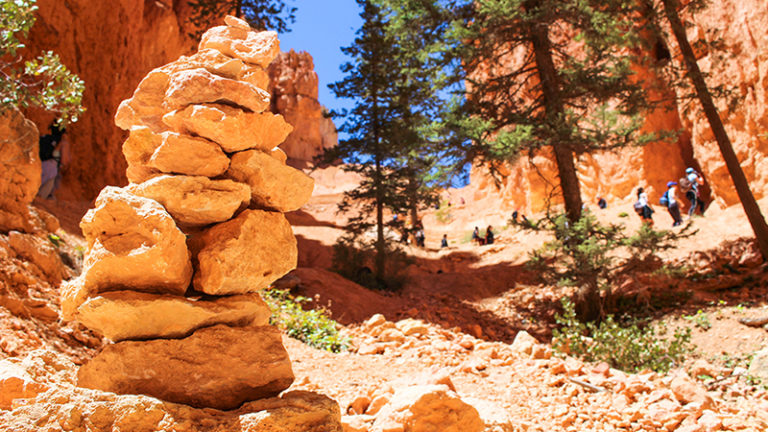
New to the world of hiking? Most people are familiar with basic etiquette for walking in a public park or on a sidewalk, such as keeping to the right side of the path. While many of the same general rules apply, you’ll want to be aware of some additional ways to show common courtesy when hiking on a trail.
Who Has the Right-of-Way?
Hikers vs. Hikers
Uphill hikers have the right-of-way over downhill hikers, as uphill hikers have a narrower line of sight than that of downhill hikers. Uphill hikers will also be more focused and “zoned in,” as they are on the more strenuous path, so it is common courtesy not to interrupt the uphill hiker’s pace.
If you would like to pass the hiker in front of you, announce your approach with a simple, “Hello, mind if I pass?”, and pass on the left.
Solo hikers should yield to larger groups, as solo hikers have more flexibility to move out of the way. If you are part of a larger group, make sure you are walking in single file, never taking up more than half the width of the path.
Hikers vs. Bikers

Officially, bikers are expected to cede the right-of-way to hikers. However, most hikers yield to bikers in order to avoid slowing the biker’s momentum, especially if the biker is going uphill.
Hikers and Bikers vs. Horses
Horses have the right-of-way over everyone else on the path, as they are large and unpredictable. If a horse is approaching you, do not make any loud noises or sudden movements that might spook the horse. Calmly move to the right side and allow the horse to pass.
In every scenario, move off the path or to the side of a wide part of the trail if you need to take a short break.
Leave No Trace

The Leave No Trace initiative means to “leave it better than you found it.” Clean up after yourself. Do not leave any food wrappers, campfire debris, dog waste, or other trash on the trail. If you pack it in, pack it out.
Do not touch or rearrange anything that would disrupt the natural state of the ecosystem. This includes building rock cairns, trampling over vegetation or leaving the path to avoid an obstacle. Even if the path is muddy, you should walk through the mud rather than around it, as many people going around will slowly carve out a wider path, which isn’t healthy for path sustainability.
Always try to use toilet facilities when available, but if you must relieve yourself while on a hike, move at least 200 feet away from trails, campsites, and water sources. If this is not possible without damaging the natural vegetation, look for a hidden area behind a rock, tree, etc. For solid waste, dig a 6-8 inch hole and cover it when you are through conducting your business.
Be Considerate

Most hiking etiquette is just common courtesy.
If you are taking a photo or video, move out of the way or ensure that you are not blocking other hikers on the path. If you are taking photos at the trail’s main attraction, such as the mountain peak, waterfall or overlook, don’t hog the best view. Take a few shots and then allow other hikers to capture their memories as well.
Don’t shout or talk loudly, especially if you are in a large group. Many people enjoy hiking to revel in the peace of the surrounding nature, and constant reminders of human presence can be very distracting.
Don’t blast music loudly on speakers or on your phone. If you want to listen to music, do so with headphones, and leave one earbud off or keep your volume low so that you can hear other hikers or signs of danger in the area.
Try to limit your use of electronics in general. After all, you’re there to enjoy the natural beauty that earth has to offer, and the best way to connect with nature is to disconnect from unnatural distractions.
Stay safe, stay courteous, and happy hiking!
